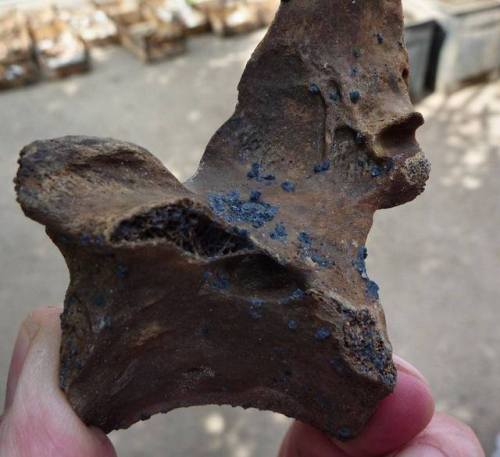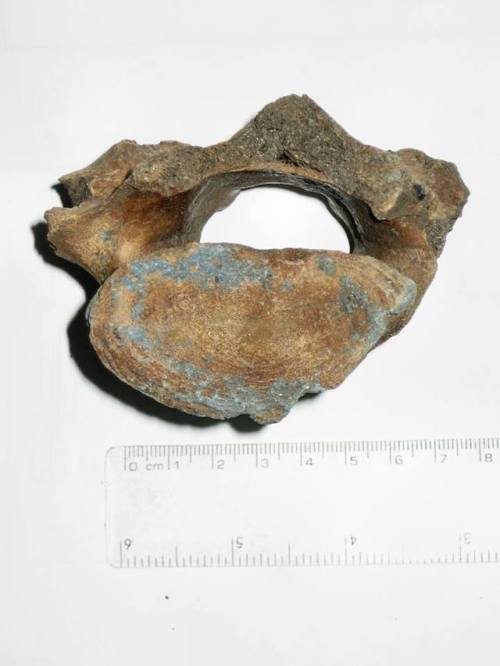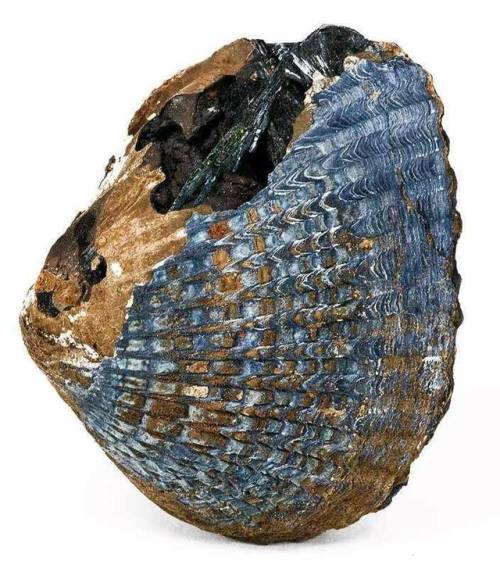When the bones go blueVivianite is a hydrated iron phosphate mineral (Fe2+3(PO4)2 · 8H2O) that can b
When the bones go blueVivianite is a hydrated iron phosphate mineral (Fe2+3(PO4)2 · 8H2O) that can be found in diverse geological environments, including the oxidation zone of metal ore deposits, granite pegmatites that contain phosphate minerals and clays and glauconitic sediments. Vivianite also shows up attached to fossil shells and bones.When vivianite forms, its crystals are colorless or pale green and transparent, but as a result of a quick process of oxidization its color changes to a deep bluish-green or deep blue (http://bit.ly/2uZQXGt).This mineral has been found several times in partially blue human remains. A good example is Ötzi, the Iceman – a 5,000-year-old man that died and his body remained frozen in the Alps. Another example are the remains of American soldiers who died in an airplane crash in South Vietnam.The reason why vivianite appears in human remains is related to how phosphate present in bones and teeth interacts with iron and water. When a person dies and the body initiates the decomposing process, the phosphate pours out into the corpse surroundings. If it happens that this environment has presence of water and it is filled with iron, the phosphate will react with these other molecules and vivianite is the result of that interaction.As mentioned above, when vivianite is formed its crystals are colorless, but due to the presence of oxygen the crystals shift into a different color – in the case of human remains, vivianite’s crystals are deep blue. As you can imagine, this creates an eerie scene for anyone who finds the cadaver.For archaeologists, vivianite can be both a good and a bad thing. When studying the DNA, this mineral is a big no-no, because vivianite can blunder the molecular process used to access DNA from biological remains – this process is called Polymerase Chain Reaction (PCR).On the other hand, the presence of vivianite in remains can be quite valuable. For instance, vivianite can bring some light to what happened to a person’s body after their death. Take the example of the American soldiers found in Vietnam: because of the presence of vivianite, scientists could determine that that group of men had been buried in drenched soil filled with iron from the rusting plane. Also, vivianite helps preserve human remains as it slows the natural decaying process. This feature is obviously of great value for archaeologists. This mineral can also help provide information about burial sites as its presence shows evidence of occasional flooding of burial grounds.Vivianite is not the only mineral that changes the color of corpses: blue-green copper minerals can appear on human cadavers if these were buried with certain items such as jewelry or bullet jackets.If you are planning on leaving a drop-dead gorgeous corpse behind, you may want to consider to be buried with some jewelry somewhere with lots of water and iron. Besides of keeping you preserved longer, you will give quite a fright to whoever unearths you.SuSources:http://bit.ly/2eO797Nhttp://bit.ly/2uYwCBOhttp://bit.ly/2tZHXwOhttp://bit.ly/2uCubSJPhoto credits:http://bit.ly/2eOr1HE - photo by Terry O'Connor/BoneCommonshttp://bit.ly/2eO7tn1 - photo by Terry O'Connor/BoneCommonshttp://bit.ly/2w13tTv - photo by Rob Lavinsky/iRocks.com -- source link
Tumblr Blog : the-earth-story.com
#fossil#fossilfriday#vivianite#chemistry#geology#archaeology#mineral#mineralogy#phosphate#phosphorus#shell#bivalve


